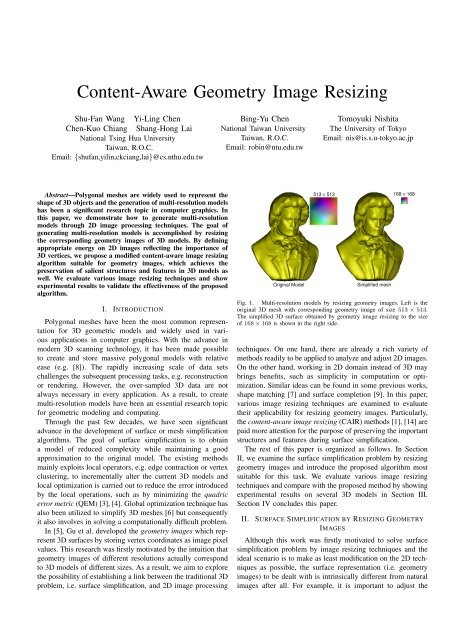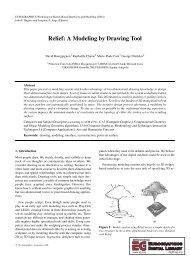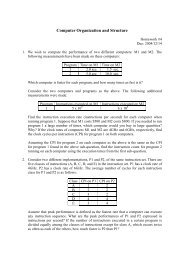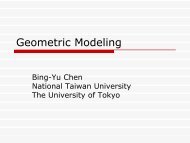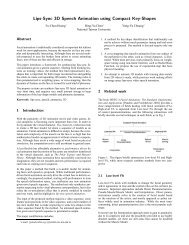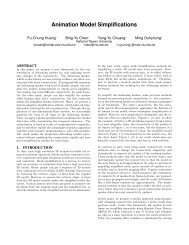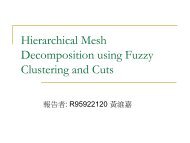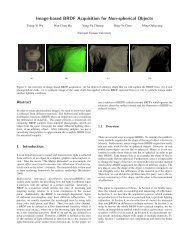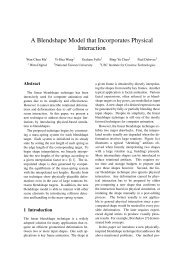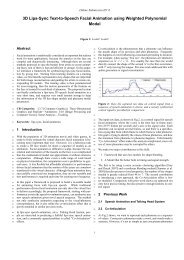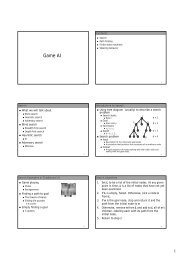Content-Aware Geometry Image Resizing - Computer Graphics ...
Content-Aware Geometry Image Resizing - Computer Graphics ...
Content-Aware Geometry Image Resizing - Computer Graphics ...
You also want an ePaper? Increase the reach of your titles
YUMPU automatically turns print PDFs into web optimized ePapers that Google loves.
<strong>Content</strong>-<strong>Aware</strong> <strong>Geometry</strong> <strong>Image</strong> <strong>Resizing</strong><br />
Shu-Fan Wang Yi-Ling Chen<br />
Chen-Kuo Chiang Shang-Hong Lai<br />
National Tsing Hua University<br />
Taiwan, R.O.C.<br />
Email: {shufan,yilin,ckciang,lai}@cs.nthu.edu.tw<br />
Bing-Yu Chen<br />
National Taiwan University<br />
Taiwan, R.O.C.<br />
Email: robin@ntu.edu.tw<br />
Tomoyuki Nishita<br />
The University of Tokyo<br />
Email: nis@is.s.u-tokyo.ac.jp<br />
Abstract—Polygonal meshes are widely used to represent the<br />
shape of 3D objects and the generation of multi-resolution models<br />
has been a significant research topic in computer graphics. In<br />
this paper, we demonstrate how to generate multi-resolution<br />
models through 2D image processing techniques. The goal of<br />
generating multi-resolution models is accomplished by resizing<br />
the corresponding geometry images of 3D models. By defining<br />
appropriate energy on 2D images reflecting the importance of<br />
3D vertices, we propose a modified content-aware image resizing<br />
algorithm suitable for geometry images, which achieves the<br />
preservation of salient structures and features in 3D models as<br />
well. We evaluate various image resizing techniques and show<br />
experimental results to validate the effectiveness of the proposed<br />
algorithm.<br />
I. INTRODUCTION<br />
Polygonal meshes have been the most common representation<br />
for 3D geometric models and widely used in various<br />
applications in computer graphics. With the advance in<br />
modern 3D scanning technology, it has been made possible<br />
to create and store massive polygonal models with relative<br />
ease (e.g. [8]). The rapidly increasing scale of data sets<br />
challenges the subsequent processing tasks, e.g. reconstruction<br />
or rendering. However, the over-sampled 3D data are not<br />
always necessary in every application. As a result, to create<br />
multi-resolution models have been an essential research topic<br />
for geometric modeling and computing.<br />
Through the past few decades, we have seen significant<br />
advance in the development of surface or mesh simplification<br />
algorithms. The goal of surface simplification is to obtain<br />
a model of reduced complexity while maintaining a good<br />
approximation to the original model. The existing methods<br />
mainly exploits local operators, e.g. edge contraction or vertex<br />
clustering, to incrementally alter the current 3D models and<br />
local optimization is carried out to reduce the error introduced<br />
by the local operations, such as by minimizing the quadric<br />
error metric (QEM) [3], [4]. Global optimization technique has<br />
also been utilized to simplify 3D meshes [6] but consequently<br />
it also involves in solving a computationally difficult problem.<br />
In [5], Gu et al. developed the geometry images which represent<br />
3D surfaces by storing vertex coordinates as image pixel<br />
values. This research was firstly motivated by the intuition that<br />
geometry images of different resolutions actually correspond<br />
to 3D models of different sizes. As a result, we aim to explore<br />
the possibility of establishing a link between the traditional 3D<br />
problem, i.e. surface simplification, and 2D image processing<br />
Original Model<br />
513 × 513 168 × 168<br />
Simplified mesh<br />
Fig. 1. Multi-resolution models by resizing geometry images. Left is the<br />
original 3D mesh with corresponding geometry image of size 513 × 513.<br />
The simplified 3D surface obtained by geometry image resizing to the size<br />
of 168×168 is shown in the right side.<br />
techniques. On one hand, there are already a rich variety of<br />
methods readily to be applied to analyze and adjust 2D images.<br />
On the other hand, working in 2D domain instead of 3D may<br />
brings benefits, such as simplicity in computation or optimization.<br />
Similar ideas can be found in some previous works,<br />
shape matching [7] and surface completion [9]. In this paper,<br />
various image resizing techniques are examined to evaluate<br />
their applicability for resizing geometry images. Particularly,<br />
the content-aware image resizing (CAIR) methods [1], [14] are<br />
paid more attention for the purpose of preserving the important<br />
structures and features during surface simplification.<br />
The rest of this paper is organized as follows. In Section<br />
II, we examine the surface simplification problem by resizing<br />
geometry images and introduce the proposed algorithm most<br />
suitable for this task. We evaluate various image resizing<br />
techniques and compare with the proposed method by showing<br />
experimental results on several 3D models in Section III.<br />
Section IV concludes this paper.<br />
II.<br />
SURFACE SIMPLIFICATION BY RESIZING GEOMETRY<br />
IMAGES<br />
Although this work was firstly motivated to solve surface<br />
simplification problem by image resizing techniques and the<br />
ideal scenario is to make as least modification on the 2D techniques<br />
as possible, the surface representation (i.e. geometry<br />
images) to be dealt with is intrinsically different from natural<br />
images after all. For example, it is important to adjust the
Fig. 2. High gradient energy in geometry image and normal map can well<br />
represent the features of a 3D object.<br />
(a)<br />
(b)<br />
contents of a geometry images I gim without destroying the<br />
topology of the corresponding 3D model, which is implicitly<br />
encoded in I gim . As a result, in order to design an effective<br />
simplification method based on geometry images, several<br />
considerations are summarized as below.<br />
a) Cost Definition:: Typically, a simplification algorithm<br />
defines a certain measure of cost to guide the simplification<br />
process, e.g. QEM [3]. Similarly, to achieve feature preservation,<br />
it will be necessary to have some saliency measure<br />
reflecting the importance of 3D vertices.<br />
b) Simplification:: With appropriate cost definition, we<br />
still need a mechanism to drive the simplification process. In<br />
this work, it is attempted to resort to a certain optimization<br />
technique that determines which pixels (i.e. mesh vertices) to<br />
be retained or eliminated. Again, it is essential to maintain the<br />
structure and topology of the original 3D models.<br />
c) Reconstruction:: To alter the geometry of 3D models<br />
unavoidably introduces errors on the simplified models. It is<br />
thus significant to compute a good position for the vertices<br />
that survive during the simplification process. In the case of<br />
image resizing, to blend several pixels to form a new one may<br />
produce good results for real images, but is not necessarily<br />
good in terms of the quality of simplified meshes.<br />
A. Saliency Measure<br />
The key to CAIR methods [1], [14], [13], [10], [11] is<br />
to change image sizes by eliminating redundant pixels while<br />
retaining the important ones. However, it is not always easy to<br />
define an appropriate saliency measure for all types of natural<br />
images. Take Fig. 3(b) as an example, simple gradient energy<br />
does not always reflect the important regions in an image for<br />
the case of highly complex and textured background. When<br />
considering the simplification of 3D meshes, it is usually<br />
preferred that the redundant vertices (e.g. with higher sampling<br />
density) will be removed with higher priority and the feature<br />
points (e.g. with sharp orientation change) tend to be retained.<br />
Recall that geometry images are 2D arrays storing various<br />
surface properties, such as 3D coordinates and normal vectors,<br />
as the RGB values. Therefore, the gradients of a geometry<br />
image and a normal map actually indicate the local sampling<br />
Fig. 3. High gradient energy does not always correspond to the important<br />
area in a natural image.<br />
density of 3D vertices and shape variation of the corresponding<br />
3D model. Despite the simplicity, the weighted combination<br />
of gradient energy derived from the geometry image and the<br />
normal map well represents the saliency map of a 3D model:<br />
E gim =<br />
E nmp =<br />
E = αE gim +(1−α)E nmp , (1)<br />
∑<br />
c∈{R,G,B}<br />
∑<br />
c∈{R,G,B}<br />
√<br />
( ∂<br />
∂x Ic gim )2 +( ∂<br />
∂y Ic gim )2 ,<br />
√<br />
( ∂<br />
∂x Ic nmp) 2 +( ∂<br />
∂y Ic nmp) 2 ,<br />
where E gim and E nmp denote the accumulated gradients over<br />
the R, G, B channels from the geometry image I gim and<br />
the normal map I nmp , respectively. Fig. 2 demonstrates an<br />
example of the saliency map corresponding to a 3D model,<br />
where the importance features can also be visually inspected.<br />
B. Proposed <strong>Resizing</strong> Algorithm<br />
In this paper, we propose to adopt the warping-based<br />
image retargeting algorithm originally developed in [14] for<br />
geometry image resizing. The problem can be formulated as<br />
solving a constrained linear system so as to recover the new<br />
position (x i,j ,y i,j ) of each pixel (i,j) under three types of<br />
constraints. Take the calculation of horizontal displacement<br />
for instance. First, each pixel is assumed to be at a fixed<br />
distance from its left and right neighbors:x i,j −x i−1,j = 1 and<br />
x i+1,j −x i,j = 1. The second constraint is to map each pixel to<br />
a location similar to the one of its upper and lower neighbors:<br />
x i,j −x i,j+1 = 0. The third constraint fits the warped image<br />
to the dimensions of the target image size: x 1,j = 1 and<br />
x W,j = W target , where W and W target denote the width of<br />
the original and resized image, respectively.<br />
Given the saliency map of I gim and I nmp , an important<br />
pixel is preferred to be warped to a new position occupied<br />
by only itself while less important ones can be safely blended<br />
(2)
In each resizing step, we adaptively decide the image size<br />
of the next step by the energy distribution. Note that I gim is<br />
square and the saliency map ranges in [0,1]. The width and<br />
height in the k-th step can be adaptively decided by:<br />
(a)<br />
Fig. 4. Resize a geometry image from 500 × 500 to 105 × 105 by using<br />
(a) progressive resizing and (b) direct resizing [14].<br />
with other unimportant neighbors. Therefore, the constraints<br />
should be weighted by the corresponding energy value:<br />
(b)<br />
E i,j (x i,j −x i−1,j ) = E i,j ,<br />
E i,j (x i+1,j −x i,j ) = E i,j ,<br />
E i,j (x i,j −x i,j+1 ) = 0.<br />
All the equations form an over-determined constrained<br />
sparse linear system. The optimal positions of the warped<br />
pixels can be obtained by minimizing the error of the above<br />
equations, which is equivalent to finding the least-squares<br />
solution of the sparse linear system:<br />
(3)<br />
Ax ≈ b ⇒ x = (A T A) −1 A T b. (4)<br />
Similarly, the coordinate variables y i,j of pixels (i,j) can<br />
also be obtained from the least-square solution of following<br />
equations:<br />
E i,j (y i,j −y i,j−1 ) = E i,j ,<br />
E i,j (y i,j+1 −y i,j ) = E i,j ,<br />
E i,j (y i,j −y i+1,j ) = 0,<br />
y i,1 = 1,<br />
y i,H = H target .<br />
There are two considerations for applying this warpingbased<br />
method to geometry image resizing. Firstly, we take<br />
a progressive strategy to gradually resize the geometry image<br />
to the target size instead of direct resizing. Progressive<br />
resizing avoids a mass of pixels of low energy to be overdecimated.<br />
Besides, progressive resizing also alleviates the<br />
self-intersection phenomenon produced by [14], which means<br />
the warped pixels are not guaranteed to be positioned in the<br />
same order horizontally and vertically as in the original image.<br />
Since geometry images implicitly encode the connectivity of<br />
3D vertices, this phenomenon results in noticeable artifacts,<br />
such as the kinks of triangular faces as shown in Fig. 4(b).<br />
Secondly, we perform bi-cubic interpolation to reconstruct<br />
appropriate pixel values after warping. In [14], the pixels<br />
mapped to the same position are averaged to obtain the<br />
new pixel value. Empirically, we found this blending strategy<br />
causes the 3D model to shrink, which becomes serious in our<br />
progressive resizing scheme.<br />
(5)<br />
√<br />
W k = H k = max( |{(i,j)|E k−1 (i,j) > λ}|,W target ),<br />
(6)<br />
where the E k−1 is the saliency map obtained from the intermediate<br />
images of the (k−1)-th step and λ is a thresholding<br />
parameter controlling the step size, which is 0.1 in our default<br />
setting. Briefly speaking, Equation (6) counts the number of<br />
pixels with energy higher than λ to decide the dimensions of<br />
resized images. To summarize, the main steps of the proposed<br />
simplification algorithm are given as below:<br />
1) Compute the gradient energy map. (Section II-A)<br />
2) Determine the target image size (W i , H i ). (Eq. 6)<br />
3) Warp I gim and I nmp to the size of (W i , H i ).<br />
4) If W i = W target and H i = H target , stop. Else go to<br />
Step 1.<br />
III.<br />
EXPERIMENTAL RESULTS<br />
In this section, we evaluate the performance of various<br />
image resizing techniques and compare the results with the<br />
proposed method. For validation, we have adopted the METRO<br />
geometric comparison tool [2] to evaluate the deviation of 3D<br />
meshes corresponding to the original and resized geometry<br />
images. The energy maps of different methods [1], [14] and<br />
the proposed method are computed by Equation (1).<br />
A. Evaluation of Various <strong>Image</strong> <strong>Resizing</strong> Methods<br />
We applied the proposed image resizing method to obtained<br />
simplified 3D models of various resolutions, as shown in<br />
Fig. 5 and . It is interesting to note that in [5] Gu et<br />
al. applied JPEG encoding to compress geometry images,<br />
which is essentially different from resizing geometry images.<br />
Compression on geometry images does not alter the complexity<br />
of the corresponding 3D models, but inevitably introduces<br />
loss in accuracy of the mesh vertices. In Fig. 5, the number of<br />
triangles of the original 3D meshes (524288) were reduced to<br />
roughly one half of the original size (278258) without causing<br />
any noticeable visual differences. As discussed in Section II,<br />
an appropriate method which best reconstructs the pixel values<br />
is desirable when performing image resizing. We use three<br />
commonly used data interpolation methods (say, bi-cubic, bilinear<br />
and nearest-neighbor interpolation) to generate multiresolution<br />
3D models of BUNNY and evaluate the deviations<br />
with the original model by using METRO. As shown in Fig. 6,<br />
bi-cubic interpolation produces best results in terms of least<br />
errors measured on the models of lower resolutions. Consistent<br />
results were obtained by resizing other 3D models and thus<br />
we adopt bi-cubic interpolation in the rest experiments when<br />
needed.<br />
For comparison, we applied different image resizing methods,<br />
include regular down-sampling (RDS), seam carving<br />
(SC) and the technique propose in [14] (VR), to generate
Original 3D Model and <strong>Geometry</strong> <strong>Image</strong> Our Results RDS VR SC<br />
Fig. 7. Surface simplification of two example models by resizing the<br />
corresponding geometry images to the target sizes of 105×105.<br />
(a)<br />
(c)<br />
Fig. 5. Multi-resolution models generated by geometry image resizing. (a)(c)<br />
512×512, (b)(d) 374×374.<br />
Surface<br />
deviation (Metro)<br />
0.06<br />
0.05<br />
0.04<br />
0.03<br />
0.02<br />
0.01<br />
Bunny<br />
(b)<br />
(d)<br />
Bi−cubic<br />
Bi−linear<br />
Nearest<br />
0<br />
100 150 200 250 300 350 400 450<br />
Width (height) of geometry images<br />
Fig. 6.<br />
Comparison of various interpolation methods.<br />
multi-resolution models to evaluate their performance. Fig. 7<br />
demonstrates an example of aggressively resizing geometry<br />
images of original size 500 × 500 to 105 × 105. As shown<br />
in Fig. 7, although RDS can roughly preserve the global<br />
structures of the original models, the important features were<br />
not well preserved. Directly resizing an geometry image (VR)<br />
produces undesirable results because the pixels of low energy<br />
are over-decimated, which greatly alters the structure of the<br />
original model. Seam carving works by iteratively removing<br />
seams of least cost horizontally and vertically. Although<br />
important pixels tend to be retained, there is no mechanism to<br />
prevent the regions of low energy from being repeatedly carved<br />
out. Moreover, the connectivity between pixels (3D vertices)<br />
becomes more and more irregular after a large number of<br />
seams are removed. The proposed method outperforms other<br />
methods in content-aware geometry image resizing.<br />
IV.<br />
CONCLUSION<br />
In this paper, we presented an improved content-aware<br />
image resizing method suitable for geometry images. Generating<br />
multi-resolution 3D models by 2D representation and<br />
processing techniques brings some benefits because geometry<br />
images are more compact representations for 3D models, and<br />
easier to render, transmit and store than traditional polygonal<br />
meshes. In addition, most 2D image processing techniques<br />
are easy to be accelerated by GPUs, which will be part of our<br />
future work. It will also be interesting to explore the feasibility<br />
of applying the proposed method to multi-chart geometry<br />
images [12] which improves the uneven regular resampling<br />
on surfaces.<br />
REFERENCES<br />
[1] Avidan, S., Shamir, A.: Seam carving for content-aware image resizing.<br />
ACM SIGGRAPH 26(3) (2007)<br />
[2] Cignoni, P., Rocchini, C., Scopigno, R.: Metro: measuring error on<br />
simplified surfaces. <strong>Computer</strong> <strong>Graphics</strong> Forum 17(2), 167–174 (1998)<br />
[3] Garland, M., Heckbert, P.S.: Surface simplification using quadric error<br />
metrics. In: ACM SIGGRAPH, pp. 209–216 (1997)<br />
[4] Garland, M., Heckbert, P.S.: Simplifying surfaces with color and texture<br />
using quadric error metrics. In: Proceedings of IEEE Visualization, pp.<br />
263–269 (1998)<br />
[5] Gu, X., Gortler, S., Hoppe, H.: <strong>Geometry</strong> images. In: ACM SIGGRAPH,<br />
pp. 355–361 (2002)<br />
[6] Hoppe, H., DeRose, T., Duchamp, T., McDonald, J., Stuetzle, W.: Mesh<br />
optimization. In: ACM SIGGRAPH, pp. 19–26 (1993)<br />
[7] Laga, H., Takahashi, H., Nakajima, M.: Spherical parameterization and<br />
geometry image-based 3d shape similarity estimation. The Visual<br />
<strong>Computer</strong> 22(5), 324–331 (2006)<br />
[8] Levoy, M., Pulli, K., Curless, B., Rusinkiewicz, S., Koller, D., Pereira,<br />
L., Ginzton, M., Anderson, S., Davis, J., Ginsberg, J., Shade, J., Fulk,<br />
D.: The digital michelangelo project: 3d scanning of large statues. In:<br />
ACM SIGGRAPH, pp. 131–144 (2000)<br />
[9] Nguyen, M.X., Yuan, X., Chen, B.: <strong>Geometry</strong> completion and detail<br />
generation by texture synthesis. The Visual <strong>Computer</strong> (Proceedings of<br />
Pacific <strong>Graphics</strong> ’05) 21(9–10), 669–678 (2005)<br />
[10] Rubinstein, M., Shamir, A., Avidan, S.: Improved seam carving for video<br />
retargeting. ACM SIGGRAPH 27(3) (2008)<br />
[11] Rubinstein, M., Shamir, A., Avidan, S.: Multi-operator media retargeting.<br />
ACM SIGGRAPH 28(3) (2009)<br />
[12] Sander, P.V., Wood, Z.J., Gortler, S.J., Snyder, J., Hoppe, H.: Multichart<br />
geometry images. In: ACM SIGGRAPH symposium on <strong>Geometry</strong><br />
processing, pp. 146–155 (2003)<br />
[13] Wang, Y.S., Tai, C.L., Sorkine, O., Lee, T.Y.: Optimized scale-andstretch<br />
for image resizing. ACM SIGGRAPH Asia 27(5) (2008)<br />
[14] Wolf, L., Guttmann, M., Cohen-Or, D.: Non-homogeneous contentdriven<br />
video-retargeting. In: ICCV, pp. 1–6 (2007)


